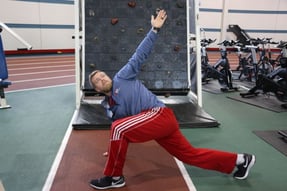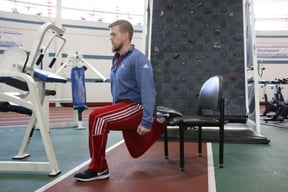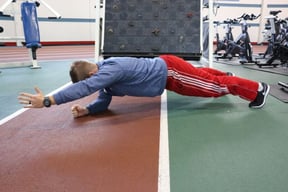 Are you uninspired on the vegetable front once the weather turns cold and the local fresh produce is no longer available? Luckily there are some hearty winter vegetables that I challenge you to try: Brussels sprouts, cauliflower, and kale. These whole foods will add some variety to your current lineup—and help you get the nutrition you need more easily. Below are recipes to try.
Are you uninspired on the vegetable front once the weather turns cold and the local fresh produce is no longer available? Luckily there are some hearty winter vegetables that I challenge you to try: Brussels sprouts, cauliflower, and kale. These whole foods will add some variety to your current lineup—and help you get the nutrition you need more easily. Below are recipes to try.
Brussels Sprouts, Quinoa, and Cranberry Salad
Serves 4–6
Ingredients
- 1 pound Brussels sprouts, rinsed and ends trimmed, then halved lengthwise and thinly sliced crosswise
- 2 cups cooked quinoa
- 1 cup dried cranberries
- ⅔ cup chopped pecans, toasted
- ¼ cup freshly squeezed orange juice
- ¼ cup olive oil
- 2 Tbsp. apple cider vinegar
- Pinch of salt and pepper
- Toss the first 4 ingredients together until combined.
- Whisk the rest of the ingredients together to make the vinaigrette and pour over the salad.
Cauliflower Fried Rice
Serves 4
Ingredients
- 1 head cauliflower, chopped into florets
- 1 small yellow onion, finely chopped
- ½ cup frozen peas
- ½ cup carrots, cubed
- 2 eggs, beaten
- 1 Tbsp. sesame oil
- ¼ cup low-sodium soy sauce
- 1 Tbsp. light brown sugar
- ⅛ tsp. ground ginger
- Pinch red pepper flakes
Instructions
- Chop head of cauliflower into florets and place in food processor. Pulse until it starts to resemble rice; set aside.
- Heat a large wok or skillet over medium heat and drizzle in sesame oil. Add onion, peas, and carrots and sauté until tender, about 2 minutes.
- Meanwhile in a small bowl, whisk together soy sauce, brown sugar, ginger, and red pepper flakes; set aside.
- Slide veggie mixture to one side of the wok and add in the beaten eggs, scrambling until cooked through, and then incorporate with the veggies.
- Stir in cauliflower "rice" and pour the soy sauce over the top, mixing well.
- Cook an additional 3 to 4 minutes, until cauliflower is soft and tender.
Turkey Sausage, Potato, and Kale Soup
Serves 10
Ingredients
- 1 Tbsp. butter
- 2 Tbsp. olive oil
- 1 yellow onion, diced
- 3 garlic cloves, minced
- 1 package (14 oz.) smoked turkey sausage, sliced into ¼-inch rounds
- 4 cups torn kale leaves
- Salt and freshly ground pepper, to taste
- 1 sprig fresh rosemary
- ½ tsp. dried thyme
- 3 cups cubed potatoes
- 32 oz. low-sodium fat-free chicken broth
- 2 cups skim milk (or alternative)
- Melt butter and heat olive oil in a large soup pot over medium-high heat.
- Add diced onions, garlic, sliced smoked turkey sausage rounds, kale, salt, pepper, rosemary, and thyme; stir to combine and cook for 8 minutes, stirring occasionally.
- Stir in potatoes. Add chicken broth and milk; bring to a boil.
- Reduce to a simmer and continue to cook 10 to 12 minutes, or until potatoes are fully cooked and tender. Remove rosemary sprig.
I hope you enjoy these winter veggie recipes and try one soon!
This blog was written by Angie Mitchell, RD, Wellness Coordinator. To find out more about the NIFS bloggers, click here.


 The New Year is just around the corner and many will be out to improve themselves on many levels in 2021, with health and fitness usually being number one on the list. If losing weight, increasing lean muscle tissue, and sculpting a lower half that will certainly turn heads, while all at the same time improving your heart health is what you are looking for, I have one answer. The use of sprints in the world of fitness and sport performance is nothing exceptionally new, but can be new to you. Actually, sprinting (fast, short bouts of running) was used to stay alive long before we used it as a mode of training.
The New Year is just around the corner and many will be out to improve themselves on many levels in 2021, with health and fitness usually being number one on the list. If losing weight, increasing lean muscle tissue, and sculpting a lower half that will certainly turn heads, while all at the same time improving your heart health is what you are looking for, I have one answer. The use of sprints in the world of fitness and sport performance is nothing exceptionally new, but can be new to you. Actually, sprinting (fast, short bouts of running) was used to stay alive long before we used it as a mode of training.  Holidays are upon us and, for many, traveling is inevitable. For at least a few days you may be on the road, in a hotel, or at a family or friend’s home. What happens to your exercise and nutritional routines that you have built and finely tuned over the past year? Do you take a break from those routines, or do you stick to them?
Holidays are upon us and, for many, traveling is inevitable. For at least a few days you may be on the road, in a hotel, or at a family or friend’s home. What happens to your exercise and nutritional routines that you have built and finely tuned over the past year? Do you take a break from those routines, or do you stick to them?



 In part 1
In part 1 Continuing with the Group Fitness Class of the Month series, December is upon us and we are highlighting a new class. Hopefully you had the opportunity in November to do a
Continuing with the Group Fitness Class of the Month series, December is upon us and we are highlighting a new class. Hopefully you had the opportunity in November to do a  PiYo at NIFS
PiYo at NIFS It seems nearly impossible that the holidays have crept upon us already! And not just that, but those dreaded
It seems nearly impossible that the holidays have crept upon us already! And not just that, but those dreaded 
 One of the most important (and sometimes overlooked) pieces of the resistance training puzzle could be right in the palm of your hands. Have you ever thought about the way you hold onto an Olympic or powerlifting bar? For some, the answer may be no. You may be worried more about other techniques, such as posture or breathing. For others, the answer may be yes. The effort you put into how you grip the bar may be your key to success in lifts such as the snatch, deadlift, and clean, among many other resistance exercises.
One of the most important (and sometimes overlooked) pieces of the resistance training puzzle could be right in the palm of your hands. Have you ever thought about the way you hold onto an Olympic or powerlifting bar? For some, the answer may be no. You may be worried more about other techniques, such as posture or breathing. For others, the answer may be yes. The effort you put into how you grip the bar may be your key to success in lifts such as the snatch, deadlift, and clean, among many other resistance exercises. 


